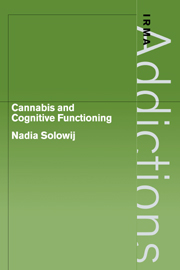Book contents
- Frontmatter
- Contents
- Series editor's preface
- Author's acknowledgements
- 1 Statement of the problem
- PART 1 A REVIEW OF THE LITERATURE
- 2 Cannabis the drug
- 3 Acute effects of cannabis on cognitive functioning
- 4 Evidence for brain damage associated with the long-term use of cannabis
- 5 Chronic effects of cannabis on cognitive functioning
- 6 Selective attention and event-related potentials (ERPs)
- PART 2 RESEARCH
- Appendix
- References
- Index
2 - Cannabis the drug
from PART 1 - A REVIEW OF THE LITERATURE
Published online by Cambridge University Press: 16 September 2009
- Frontmatter
- Contents
- Series editor's preface
- Author's acknowledgements
- 1 Statement of the problem
- PART 1 A REVIEW OF THE LITERATURE
- 2 Cannabis the drug
- 3 Acute effects of cannabis on cognitive functioning
- 4 Evidence for brain damage associated with the long-term use of cannabis
- 5 Chronic effects of cannabis on cognitive functioning
- 6 Selective attention and event-related potentials (ERPs)
- PART 2 RESEARCH
- Appendix
- References
- Index
Summary
Cannabis is the material derived from the herbaceous plant Cannabis sativa which grows vigorously throughout many regions of the world. It occurs in male and female forms with both sexes having large leaves which consist of 5–11 leaflets with serrated margins. A sticky resin which covers the flowering tops and upper leaves is secreted most abundantly by the female plant and this resin contains the active agents of the plant. While the cannabis plant contains more than 60 cannabinoid compounds, such as cannabidiol and cannabinol, the primary psychoactive constituent is delta-9-tetrahydrocannabinol or THC (Gaoni & Mechoulam, 1964), the concentration of which largely determines the potency of the cannabis preparation. Most of the other cannabinoids are either inactive or only weakly active, although they may increase or decrease potency by interacting with THC (Abood & Martin, 1992).
Previously cannabis had been erroneously classified as a narcotic, as a sedative and most recently as a hallucinogen. While the cannabinoids do possess hallucinogenic properties, together with stimulant and sedative effects (Dewey, 1986; Adams & Martin, 1996), they in fact represent a unique pharmacological class of compounds. Unlike other hallucinogenic drugs, cannabis acts on specific receptors in the brain and periphery. The recent discovery of the receptors and the naturally occurring substances in the brain that bind to these receptors, is of great importance in that it signifies an entirely new pathway system in the brain.
The cannabinoid receptor
The desire to identify a specific biochemical pathway responsible for the expression of the psychoactive effects of cannabis has prompted a prodigious amount of cannabinoid research (Martin, 1986).
- Type
- Chapter
- Information
- Cannabis and Cognitive Functioning , pp. 13 - 28Publisher: Cambridge University PressPrint publication year: 1998

